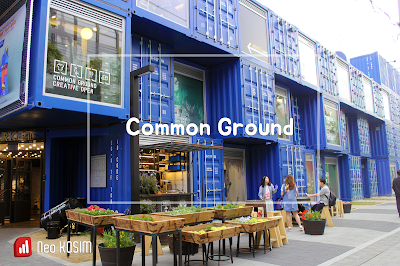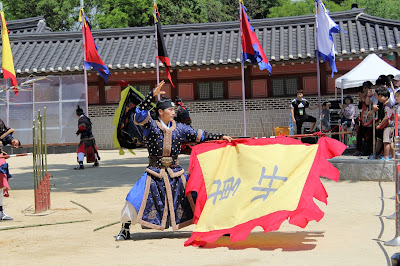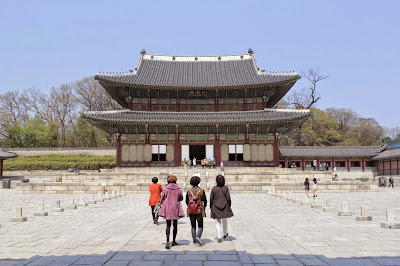“My round of Joseon dynasty shall be different from the
previous kings.”
The kings who eagerly dreamed a good and wise king than
as before. The place where left their passion and anguish, I visited just the Changdeokgung
palace complex.
The Changdeokgung(
창덕궁),
literally ‘prospering virtue palace’, is the palace of Joseon Dynasty which is
the most beautiful, longest, being loved one to the kings and well preserved
place at present time. Changdeokgung was designated on UNESCO World Heritage in
1997 with an outstanding exceptional example of Far Eastern palace architecture
and design, blending harmoniously with the surrounding landscape. With this
historical and beautiful value, the first ladies of G20 visited this palace in
Nov2010 during G20 Summits period.
The history of Changdeokgung palace and
location
This was built as a secondary palace in 1405 by the order
of King Taejong, 3rd king of Joseon dynasty. It is located at the
foot of Ungbong Peak of mountain Bugaksan in Seoul. It is named also ‘East Palace’ along
with Chaggyeonggung because it is situated in the east side of Gyeongbok
palace, the primary palace. Each complex is placed in harmony with the
topography without regular system as contrast with the Gyeongbok palace which
is overawed and authoritative by standing the line and symmetrical placement in
flatland. Korea is mountainous country. As this reason, the kings might be more
familiar than the flat main palace. All palace in Hanyang( today’s Seoul) was
destroyed by the Japanese invasion (1592-1598). As talking of inauspicious side
in Gyeongbok palace, Changdeok palace reconstructed and took over as a new royal court by the
King Gwanghaegun until Gyeongbok palace rebuilt in 1865 and was used through
several process of destroy and reconstruction till the end of dynasty( almost
500 years).
The distinct feature of Changdeonggung
palace complex and Secret garden

Palace, up to 50000 square meters, is divided into front
outer yards consisted of the governmental offices, royal private residential
area and inner yards of the rear garden (secret garden).This dynasty was
established by the base of Confucian ideology. The principle of it was “Humble and
Simple”. It was also applied when the palace complex was constructed. However they did
not give up their attempt to make it graceful and elegant instead of being glossy. Especially,
garden area (rear garden, secret garden), well composed by pavilions, ponds,
trees, oddly shaped stones and rocks shows outstanding view especially boast
characteristic and beautiful harmony with nature. This has the feature of
untypical aesthetic value of beauty. People thought Gyeongbok palace as the
inauspicious site in some side although it was the primary palace according to Fengshui principle, Chinese geomantic
principles, many kings preferred to stay new Changdeok palace (창덕궁) from the beginning period of dynasty.
The vicinity of Donhwamun Gate(돈화문)
This is the oldest main palace gate, built in 1412 and
reconstructed during the King Gwanghaegun period(in 1608), and is two stories
building where bell and bass drum were installed for alarming of the time(not
inside at present time). This was exclusive gate for the king when he went for
the Jongmyo shrine where the royal family’s ancestral tablets were placed
and ancestral rites were performed regularly during the Joseon dynasty. The gatekeepers’
quarter was changed into the stone wall at now. Besides, a new road was opened
between palace and Jongmyo shrine in Japanese occupation period. So it is no
more accessible as free as like the past, is true to get an very stuffy impression.
The Injeongmoon gate and yard(인정문)
 |
| captured by book Changdeokgung written Jongdeok Choi |
After passing by the oldest Geumcheongyo stone bridge and one gate
again, I reached at Injeongmoon gate. In front of this gate, in general, the
coronation of a king was held concisely on 6th day of the death of
previous king because the throne couldn't leave it empty for long time after death of former king. For a moment, I visualized the ideal and passion of new king in
my mind. This yard has the trapezoidal type instead of typical rectangular one.
Maybe this was caused by the purpose of avoiding the mountain terrain leading
to the Jongmyo shrine.
The Injeongjeonjeon Hall and vicinity(인정전)
This is the national treasure and main hall of palace. Official
grand ceremonies like as audiences with ministers, reception of foreign envoys
and so on were held. The external appearance looks like two stories building,
but the inside is one story building having the glossy interior and high
ceiling.
At the front, there were the king’s seat and the
folding screen on the back of the chair which means the world of ruling by the king(painted the sun,
moon, five peaks and two fast-flowing cascades usually shown in
the historic drama in television). Present appearance was reconstructed in 1804
after several destroy and rebuilt. In 1900’, and thus it shows various combined cultural elements by adopting the Western
culture( eg, the light, curtain and gloss window was equipped and the clay stone
floor was changed into wood).
 |
The guardians of palace on the eaves (Japsang 잡상),
Korean traditional decorative coloring on wood ( Dancheong 단청)
Clay
dolls on the eaves of tiled roof, Japsang (잡상,the meaning is several
shape) which they are from the characters of Chinese novel HsiYuChi(journey to
the West), are the guardians protecting the people from devil. Dancheong(단청), Korean traditional decorative coloring on
wood building and artifacts, using only five colors( each color means; blue-east
white-west red-south black-north
yellow-center), works not only as decoration role but also for practical
purposes such as to protect building surfaces against temperature or insects and make the
crudeness of materials less conspicuous. |
 |
left; Deumeu(드므)
right;rank stones for officials and thin-layered stone plates on the floor |
Deumeu(드므),
the vessel keeping for firefighting water, has the symbolic superstitious meaning that fire
devil surprised at his reflection image in the water and ran away. Officials
stood in line according to their rank on the back side of the stone. The higher
they are, the closer they are to the king. The civil official stood on the east
side, the military one did on the west side. Thin layered stone plates being cut along
the grain into 10~20-cm-thick slice on the front yard of this building makes
this hall more prominent architecture. This type of stone prevented to slip down
by the rain and to dazzle by the strong sunlight. Civil service
literary examinations were held in this yard. Through the resurface the yard,
now a day the stone was replaced with flat type stones, it diminished the scent
of the past regretfully.
Huijeongdang Hall and Daejojeon Hall for
the royal family residential court
 |
| Huijeongdang Hall(휘정당) |
This was used for the king’s chamber at first, used for
council in the later. This was rebuilt in 1920 by using the materials of the Gangnyeongjeon
of Gyeongbok palace after destroyed by the fire in 1917. At that time, they
adopted the style of Chinese in Beijing and Western style in many part of this
building.
 |
| The flower steps of Daejojeon rear yard(대조전) |
This is the official residence of the queen. Also many kings were born
and died in here. The flower steps, in general, for the space of women,
composed to plant flowers or trees on the sloping hill. (in Daejojeon rear
yard)
The buildings for the rising sun; for the
little crown prince
 |
| Heuiwooru(희우루) on the opposite site of secret garden ticketing office |
Heuiwooro was the lecture room for the little prince and
changed the purpose into the space of traditional doctor for caring the king
later.
The Nakseonjae hall and vicinity, the nest
of the young King Heonjong for his lover
 |
Nakseonjae(낙선재)
These buildings, Nakseonjae(낙선재), Seokbokheon and Sugangjae, were built in
1847 for the royal concubine in King Heonjong reign. After his first queen
died, he exceptionally attended the selection site for coming new queen. But his grandmother chose
another girl instead of the girl who was fixed in his mind on. As the no prince was
born in three years, he finally took the girl as the royal concubine. This
vicinity was composed of humble, simple and in neat like the houses of the
Joseon literati, but the hidden refine in places made me feel another
aesthetic. The king spent the times with her at his rest time in Nakseonjae. Seokbokheon
is the residential house for her on the next door. However, their dramatic love
story did not last so long (just for three years only) because the king died of
disease at the age of 22. She lived until 76 years old. Love like as the short
spring time! |
 |
| the outside view sitting on the floor |
 |
| ice pattern under the floor |
The small wall for firefighting has the pattern of ice under the
floor.
The Secret Garden(비원), the
most attractive destination of this palace
Huwon (rear garden),Biwon (secret garden) Forbidden
garden( due to restriction area by the king) North garden (located on the north
site). It has been named so many names as before. Present name ‘Secret garden’
was derived from the office name to maintain this garden in Japanese occupation
period. However the name used through long period was the ‘Huwon’. They planted
the flowers and broad-leaved trees, up to 26000 specimens of 100 indigenous
trees, made many beautiful pavilions, lotus ponds and other architectures along
the topography in each valley harmoniously. This was accessed from both
Changdeokgung and Changgyeonggung palace because there was no barrier between
them in the past till Japanese occupation period (1910-1945). This is the
palace garden where royal family members strolled and meditated in private. This
was used also for venue for banquets, military drill, archery range and so on.
The ideal and vision of King Jeongjo,
Buyongjeong, Pond and Juhamnu Pavilion
 |
| Buyongji pond(부용지) |
In the pond, small islet means round sky and square means
land . Buyongjeong(부용정),re-opened
in 2012, is the architectural highlight of the Korean traditional pavilion.
 |
| Buyongjeong(부용정) |
The
cross-shape of the pavilion symbolizes the full blooming lotus and the two
stone legs on the front part seem like man submerges his leg to the pond. The
King Jeongjo rebuilt this one and changed it into present name. He invited
high-ranking officials, made fishing, had their legs submerged on the pond,
floated the boat and made poems. Person who did not compose poem in time
dropped this small islet as a penalty for a short time. His father was killed
in the rice chest by his grandfather King Yeongjo when he was a child. He
wanted to communicate with all his heart to his officials and dreamed the new
era of Joseon dynasty.
 |
| front; Eosumun(어수문) rear; Juhamnu(주합루) |
The Juhamnu(주합루)
of 2 story building located on the opposite site, is the site where preserved and
published the books ( on 1st floor) and discussed the knowledge and
politics with young talented people(on 2nd floor). The sign board of
this entrance(Eosumun) contains his hope that officials show their ability in
full in front of king as like fish meets the water. The era without political
strife, he was a real good and wise king left many great brilliant achievement.
The Aeryeonji Pond
 |
| Aeryongji pond(애련정) |
In summer, this pond was filled with lotus flowers. It
blossoms beautiful flower in the dirty soil pond. It symbols the men of virtue.
The Jondeokjeong Pavilion and vicinity
 |
| Seungjaejeong(승재정) from the Jondeokjeong(존덕정) |
This was the pond of gourd-shaped bottle at first and
reduced to this size resembling the Korean peninsula map shape. Along the line
of this pond each pavilion boasts its beauty of itself.
 |
| Jondeokjeong(존덕정) |
 |
| blue and yellow dragon ceiling and poem tablet in the right |
The hexagonal pavilion of the double-layered roof and
ceiling in blue and yellow dragon and poem tablet of King Jeongjo. “ Small
streams may shine under the moonlight, but there is only one moon”
The Ongnyucheon Stream and vicinity (Jade
Stream)
 |
| Cheongui pavilion(청의정) |
Cheongui pavilion is the place of rice seedling by the
king and made the roof from straw cultivated in this field. Roof made from
straw instead of heavy tiled roof is very impressive and skinny pillar and
rafter looks very light like as slim girl.
The Yeongyeongdang Hall
This residential area having 120 rooms was built for the
Jinjakrye ceremony of King Sunjo by Crown Prince Hyomyeong in 1828 and rebuilt
in 1865. It has the style of household of the gentry despite of location in the
palace area. King Sunjo lived here for a short year when he substituted his
thrown into his crown prince. This has double zone for King’s
quarter(Sarangchae사랑채 such as
living room) and Queen’s quarter(Anchae안채
such as inner private room).
 |
| King's quart(사랑채) |
 |
| Queen's quarter(안채) |
 |
| Seonhyangjae(선향재) is the study having Chinese style side wall and Western style blind |
 |
| Nongsujeong pavilion(농수정) |
I love this palace which endures so long hard times.
 |
| Chinese Juniper tree 750 years old |
 |
Wonderful shot !!!
Those girls wearing Hanbok(Traditional dress of Korea)
|






































































